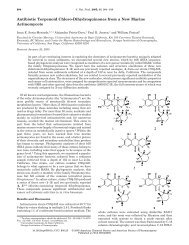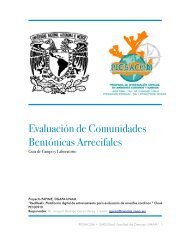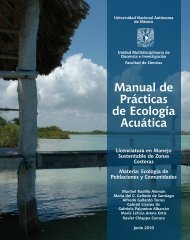Cap 1 Hidrodinamica de Lagunas Costeras.pdf
Cap 1 Hidrodinamica de Lagunas Costeras.pdf
Cap 1 Hidrodinamica de Lagunas Costeras.pdf
Create successful ePaper yourself
Turn your PDF publications into a flip-book with our unique Google optimized e-Paper software.
Hidrodinámica <strong>de</strong> <strong>Lagunas</strong> <strong>Costeras</strong><br />
140 h u* y 500 h u*, y aún en casos extremos, hasta 7500 hu* (Fischer et al, 1979). Esta<br />
disparidad con la expresión <strong>de</strong> El<strong>de</strong>r se <strong>de</strong>be a que esta última consi<strong>de</strong>ra el canal infinitamente<br />
ancho <strong>de</strong>spreciando los gradientes laterales <strong>de</strong> velocidad y las variaciones laterales <strong>de</strong> la<br />
profundidad <strong>de</strong>bidas a las irregularida<strong>de</strong>s <strong>de</strong> la batimetría real. Para evaluar la influencia <strong>de</strong> estas<br />
fluctuaciones es necesario consi<strong>de</strong>rar que la velocidad (u) y la profundidad (h) <strong>de</strong>pen<strong>de</strong>n <strong>de</strong> la<br />
coor<strong>de</strong>nada lateral (y), y <strong>de</strong>finir en cada corte seccional <strong>de</strong> la laguna los valores medios verticales<br />
<strong>de</strong> la velocidad (para diversas posiciones laterales (y):<br />
0<br />
z 1<br />
u ( y)<br />
= ∫ u(<br />
y,<br />
z)<br />
dz<br />
(3.145)<br />
h(<br />
y)<br />
− h(<br />
y)<br />
y las <strong>de</strong>sviaciones <strong>de</strong> estos valores medios verticales con respecto al valor medio lateral <strong>de</strong><br />
todos los valores medios verticales<br />
,<br />
u ( y)<br />
y<br />
z<br />
u :<br />
z<br />
= u ( y)<br />
− u<br />
y<br />
z<br />
(3.146)<br />
aplicando a estas <strong>de</strong>sviaciones laterales en el corte seccional el análisis tradicional <strong>de</strong> Taylor<br />
ya visto, se obtiene para el coeficiente <strong>de</strong> dispersión longitudinal en esa sección:<br />
K<br />
1<br />
= −<br />
A<br />
∫<br />
b<br />
0<br />
,<br />
u ( y)<br />
h(<br />
y)<br />
∫<br />
y<br />
1<br />
ε ( y)<br />
h(<br />
y)<br />
∫<br />
0 0<br />
t<br />
y<br />
,<br />
u ( y)<br />
h(<br />
y)<br />
dydydy<br />
(3.147)<br />
siendo A el área <strong>de</strong> la sección transversal.<br />
Esta última expresión pue<strong>de</strong> adimensionalizarse usando las variables ya <strong>de</strong>finidas<br />
y<br />
anteriormente, a<strong>de</strong>más <strong>de</strong> la profundidad adimensional: h'(y) = h(y)/ h , quedando:<br />
y<br />
2 , 2<br />
b u<br />
K =<br />
(3.148a)<br />
E<br />
I<br />
,<br />
en que I = −∫ u h ∫ , , ∫<br />
1<br />
0<br />
1<br />
ε h<br />
, ,<br />
y y<br />
, , , ,<br />
" u"<br />
h dy dy dy<br />
0 0<br />
(3.148b)<br />
Estas expresiones y el análisis <strong>de</strong> Taylor prece<strong>de</strong>nte, a<strong>de</strong>más <strong>de</strong> estar limitadas en escala<br />
temporal <strong>de</strong> aplicación al tiempo <strong>de</strong> mezcla total, <strong>de</strong>ben ajustarse y revisarse en casos reales<br />
porque:<br />
A) los rios no son canales longitudinalmente uniformes, es <strong>de</strong>cir, las secciones transversales<br />
cambian a lo largo <strong>de</strong> x;<br />
B) hay numerosas irregularida<strong>de</strong>s difíciles <strong>de</strong> cuantificar (curvaturas, bancos <strong>de</strong> arena,<br />
pozos, bolsillos laterales, objetos hundidos, etc.) que contribuyen aditivamente a la dispersión<br />
longitudinal, causando:<br />
1) aumento en el tiempo <strong>de</strong> mezcla total o <strong>de</strong> inaplicabilidad <strong>de</strong>l análisis;<br />
146







